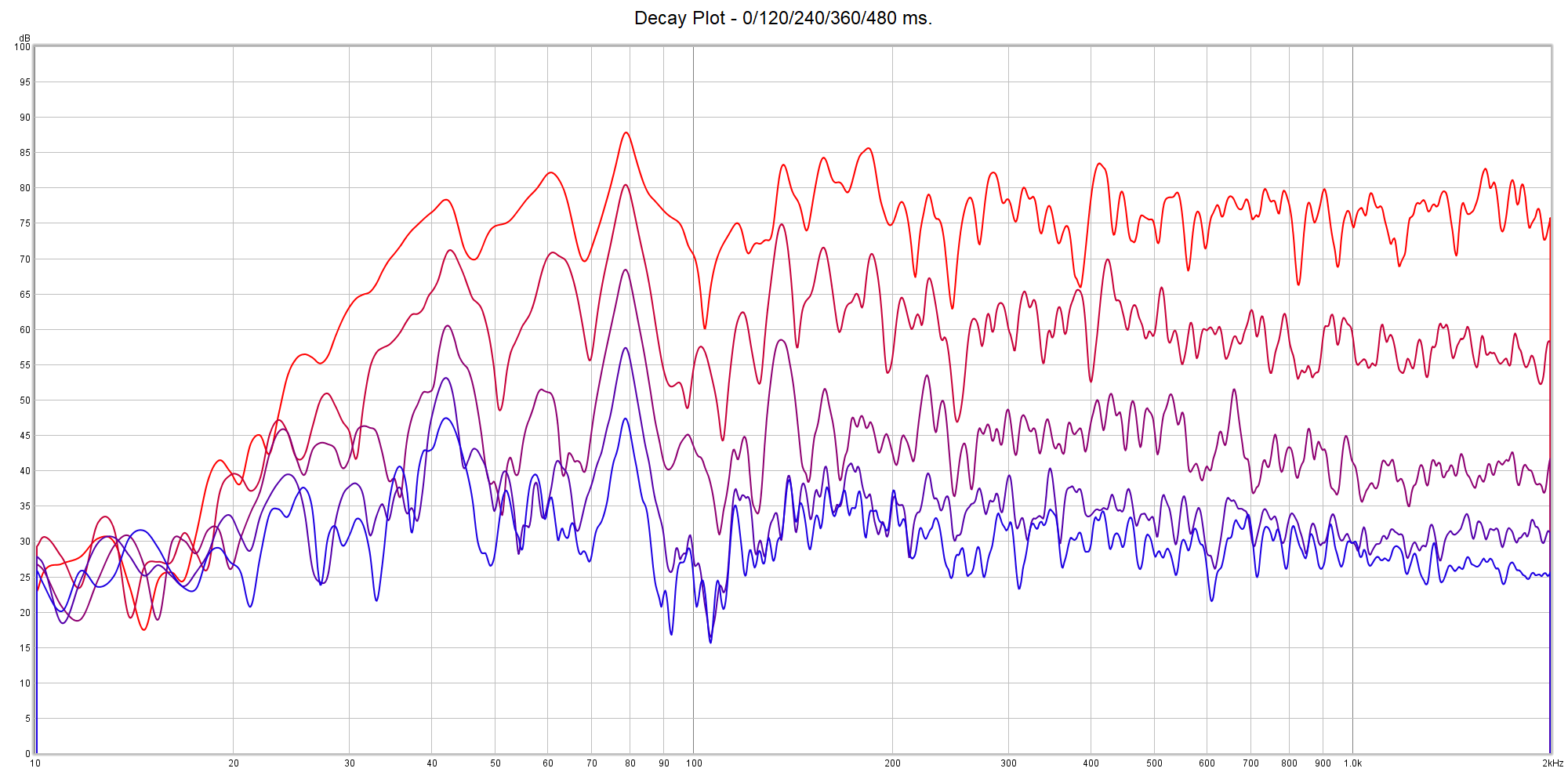


Copyright 2022, 2023, 2024 - Mediarooms Technology LLC - All rights reserved
About Acoustic Analysis
Decay (Response vs. Time) Graph
Waterfall Graph
Have you encountered a problem in your studio, mix room, meeting room or place of worship,
where things just didn’t sound right?
Perhaps your tracks sound different when you play them in different rooms. Perhaps the low frequency region is muddy, muffled, inaccurate, or just sounds bad in some hard-to-describe way. Or the sound’s localization is mushy or jumps around. Or perhaps those speaking in a conference room are unintelligible. Or the preacher’s sermons aren’t understandable by the congregation. Or it just sounds inexplicably wrong.
These can all be fixed, but only if we can find out exactly what is going on.
Acoustics is not well understood by those outside the practice; it can seem to be magic or a dark art. This often results in facility operators treating rooms haphazardly and without a plan or direction, based instead on rumor, hearsay, or guesswork.
If they're very lucky, they stumble upon a room treatment plan that happens to improve the room's acoustics. But far more often the results of all this hard work and expense are disappointing. And that old prankster, confirmation bias, can lead us to think something is working when it may in fact just be trading one problem for another, if it does anything at all.
Enter our Acoustic Analysis. This collects a wide array of information on your room, which we then scrutinize to reveal the causes of the poor sound quality. We don’t rely on listening tests, as these can be skewed by head colds, emotional states, personal bias and other misleading conditions.
An Acoustic Analysis is honest and unbiased, and is THE tool that gives direction to determining how best to treat a room. Using specialized software, a measurement microphone, and a reference quality speaker, a test signal is generated by the software, played over the reference speaker in the room, and recorded back into the computer via the measurement mic.
The software then crunches this data and generates graphs illustrating everything that is happening to sound in the room. There are 12 basic graphs available, each with nearly limitless variations, that illustrate every aspect of the room's acoustic signature, like the sample decay and waterfall graphs shown here.
The graphs reveal the problems to our trained eye in great detail, and our years of experience give us the ability to propose specific courses of action that will solve the problems. This allows you to get real results you can hear, by treating the real issues effectively. No guesswork, no shots in the dark or hearsay, and no treatments installed just because "that's what everyone does".
In a nutshell, the Acoustic Analysis exactly identifies a room’s problems so they can be fixed with precision and permanence. This is the advantage you get from an Acoustic Analysis - detail, accuracy, enlightenment, and direction.
The result is an Acoustic Analysis of your room provides the deep detail that allows us to create the ideal outcome for you - a room where sound becomes balanced, clear, and supportive. Soundtracks and music come alive, meetings and conversations flow effortlessly with clarity, and every nuance is audible. A well-designed acoustically treated space becomes more than just a room; it becomes an immersive experience.
Perhaps your tracks sound different when you play them in different rooms. Perhaps the low frequency region is muddy, muffled, inaccurate, or just sounds bad in some hard-to-describe way. Or the sound’s localization is mushy or jumps around. Or perhaps those speaking in a conference room are unintelligible. Or the preacher’s sermons aren’t understandable by the congregation. Or it just sounds inexplicably wrong.
These can all be fixed, but only if we can find out exactly what is going on.
Acoustics is not well understood by those outside the practice; it can seem to be magic or a dark art. This often results in facility operators treating rooms haphazardly and without a plan or direction, based instead on rumor, hearsay, or guesswork.
If they're very lucky, they stumble upon a room treatment plan that happens to improve the room's acoustics. But far more often the results of all this hard work and expense are disappointing. And that old prankster, confirmation bias, can lead us to think something is working when it may in fact just be trading one problem for another, if it does anything at all.
Enter our Acoustic Analysis. This collects a wide array of information on your room, which we then scrutinize to reveal the causes of the poor sound quality. We don’t rely on listening tests, as these can be skewed by head colds, emotional states, personal bias and other misleading conditions.
An Acoustic Analysis is honest and unbiased, and is THE tool that gives direction to determining how best to treat a room. Using specialized software, a measurement microphone, and a reference quality speaker, a test signal is generated by the software, played over the reference speaker in the room, and recorded back into the computer via the measurement mic.
The software then crunches this data and generates graphs illustrating everything that is happening to sound in the room. There are 12 basic graphs available, each with nearly limitless variations, that illustrate every aspect of the room's acoustic signature, like the sample decay and waterfall graphs shown here.
The graphs reveal the problems to our trained eye in great detail, and our years of experience give us the ability to propose specific courses of action that will solve the problems. This allows you to get real results you can hear, by treating the real issues effectively. No guesswork, no shots in the dark or hearsay, and no treatments installed just because "that's what everyone does".
In a nutshell, the Acoustic Analysis exactly identifies a room’s problems so they can be fixed with precision and permanence. This is the advantage you get from an Acoustic Analysis - detail, accuracy, enlightenment, and direction.
The result is an Acoustic Analysis of your room provides the deep detail that allows us to create the ideal outcome for you - a room where sound becomes balanced, clear, and supportive. Soundtracks and music come alive, meetings and conversations flow effortlessly with clarity, and every nuance is audible. A well-designed acoustically treated space becomes more than just a room; it becomes an immersive experience.

